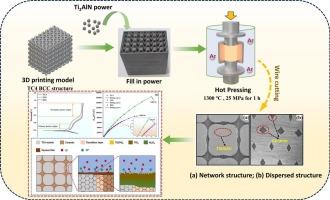Ti2AlN/TC4互穿相复合材料的制备及其耐海洋腐蚀性能
IF 6.9
2区 材料科学
Q2 CHEMISTRY, PHYSICAL
引用次数: 0
摘要
采用SLM 3D打印和热压混合技术成功制备Ti2AlN/TC4互穿相复合材料(Ti2AlN/TC4 IPCs)。研究了Ti2AlN/TC4 IPCs在3.5 wt% NaCl溶液中的电化学行为。结果表明:与TC4合金相比,网状Ti2AlN增强的IPCs表面具有更低的电流密度、更高的阻抗和更少的被动膜缺陷;Al2O3和TiO2在膜深度上较高的含量和优化比例,使TiO2优异的化学稳定性与Al2O3良好的密封性充分结合,提高了网状结构IPCs表面钝化膜的稳定性和致密性。此外,薄膜表面丰富的Ti(OH)x有助于钝化膜的稳定。连续的Ti2AlN网络在物理上阻断了腐蚀的扩散,而过渡层的优化钝化能力在化学上稳定了脆弱的金属/陶瓷界面。这种物理屏障效应和电化学钝化相结合的双重保护机制从根本上解释了Ti2AlN/TC4 ipc具有优异的耐腐蚀性。本文章由计算机程序翻译,如有差异,请以英文原文为准。

Fabrication of Ti2AlN/TC4 interpenetrating phase composites and their corrosion resistance in marine environment
Ti2AlN/TC4 interpenetrating phase composites (Ti2AlN/TC4 IPCs) were successfully fabricated via hybrid SLM 3D printing and hot-pressing techniques. The electrochemical behavior of Ti2AlN/TC4 IPCs in 3.5 wt% NaCl solution was studied. The results showed that the surface of IPCs with network structure Ti2AlN reinforcement exhibited remarkably lower current density, higher impedance and fewer passive film defects compared to the TC4 alloy. The higher content and optimized ratio of Al2O3 and TiO2 across the film depth made the excellent chemical stability of TiO2 fully combined with the better sealing of Al2O3, which improved the stability and compactness of surface passive film of the network structure IPCs. Furthermore, the abundant Ti(OH)x on the film surface contribute additional stabilization to the passive film.The continuous Ti2AlN network physically blocked the diffusion of corrosion while the optimized passivation capability of transition layer chemically stabilized vulnerable metal/ceramic interface. This dual protection mechanism, combining physical barrier effects and electrochemical passivation, fundamentally accounted for the superior corrosion resistance of the Ti2AlN/TC4 IPCs.
求助全文
通过发布文献求助,成功后即可免费获取论文全文。
去求助
来源期刊

Applied Surface Science
工程技术-材料科学:膜
CiteScore
12.50
自引率
7.50%
发文量
3393
审稿时长
67 days
期刊介绍:
Applied Surface Science covers topics contributing to a better understanding of surfaces, interfaces, nanostructures and their applications. The journal is concerned with scientific research on the atomic and molecular level of material properties determined with specific surface analytical techniques and/or computational methods, as well as the processing of such structures.
 求助内容:
求助内容: 应助结果提醒方式:
应助结果提醒方式:


